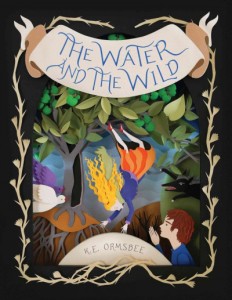Come away, O human child!
To the waters and the wild
With a faery, hand in hand,
for the world’s more full of weeping than you can understand.
Above is the epigraph for K.E. Ormsbee’s middle grade novel, The Water and the Wild. It is an excerpt from a poem by William Butler Yeats entitled “The Stolen Child”, and it is the poem from which the novel borrows its name. It’s fitting, seeing as how the story carries such a magical, curiously literary tone. That’s the thing about good middle-grade: if it’s written well and written right, it’s not just a story to entertain young readers. It’s a story to be savored by all ages, a story that charms with its characters and magic and innocent inclinations. But I guess that’s any good children’s book really. I’ve been on a huge middle grade kick lately and am currently trying to bring anyone and everyone into the fold, mostly by putting this book into their hands.
 The story follows Lottie Fisk, an imaginative orphan living with a less than pleasant guardian. She stores her treasures in a copper keepsake box underneath a green apple tree in her front yard, and curiously, whenever she writes a letter and places it in her box under the apple tree, she receives a reply. The novel takes off when Lottie’s only friend Eliot is diagnosed as “otherwise incurable” and slowly gets sicker. Lottie writes a pleading note to the letter-writer, asking for a cure. Several months letter, a mysterious girl appears at her window in the night, claiming that her father is not only the best healer on the island where she lives, but also Lottie’s letter-writer. And so Lottie is whisked away by apple tree to a mysterious land of magic and mysteries and fairies and kings, desperate to find a cure for her dear friend Eliot.
The story follows Lottie Fisk, an imaginative orphan living with a less than pleasant guardian. She stores her treasures in a copper keepsake box underneath a green apple tree in her front yard, and curiously, whenever she writes a letter and places it in her box under the apple tree, she receives a reply. The novel takes off when Lottie’s only friend Eliot is diagnosed as “otherwise incurable” and slowly gets sicker. Lottie writes a pleading note to the letter-writer, asking for a cure. Several months letter, a mysterious girl appears at her window in the night, claiming that her father is not only the best healer on the island where she lives, but also Lottie’s letter-writer. And so Lottie is whisked away by apple tree to a mysterious land of magic and mysteries and fairies and kings, desperate to find a cure for her dear friend Eliot.
One of the strongest points of this novel is the unique world and magic system. The way Mr. Wilfer mixes his cures, the use of birds as messengers known as genga, the unique gifts each sprite in the magical world of New Albion is born with are all new explorations into the idea of magic. The history of New Albion is interesting as well. It is a country split into two courts, Southerly and Northerly, with very different traditions and a deal of animosity between the two. In sum, this isn’t a fantasy world where you can assume anything. All of the magic systems and fantasy history are new and unfamiliar, making it that much harder to guess what will happen.
The novel also charms with its use of poetry. There is Lottie’s circling back to Yeat’s “The Stolen Child”, but there is also the character of Oliver Wilfer, who has memorized poetry and often spouts stanzas when he believes they will be relevant or helpful.
The added bits of poetry and the dream-like narrative quality give The Water and the Wild an enchanting, literary quality. It’s a lovely romp of a middle-grade novel, with all the essential quirks and characters to please ten and twenty year-olds alike with a taste for the fantastical. So come away o human child, won’t you please?


Comments are closed.